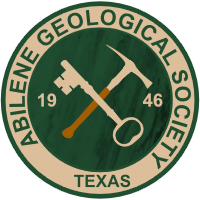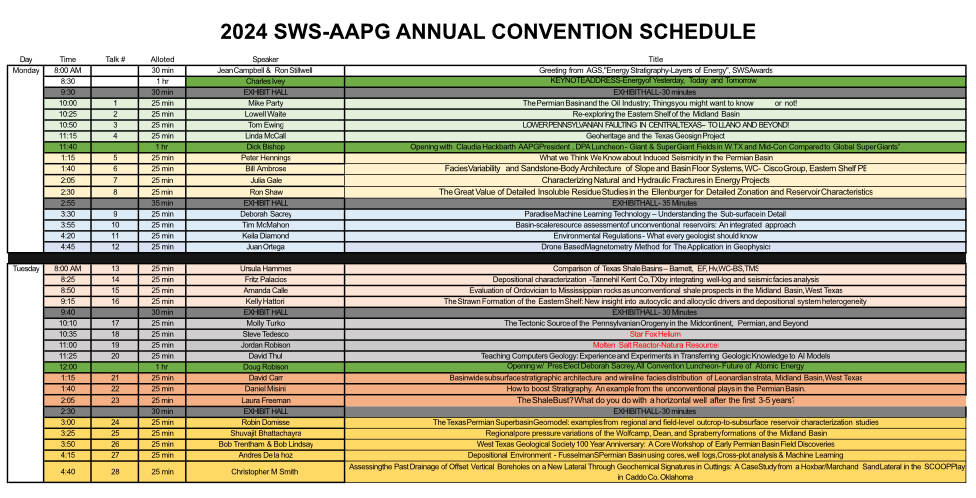
September 17, 2020 Meeting
Fellow AGS members,
I hope this finds everyone doing well and staying healthy. We are no doubt experiencing unprecedented times. Being adaptable and flexible are skills and behaviors that are essential to our new and ever-changing circumstances. Those skills are certainly not unfamiliar to Geoscientists, and especially those working in the constant ebb and flow of the energy industry. With that said, the AGS now finds itself in a position where it must adapt to these times as well. In order to provide talks for our meetings, a fair number of the speakers this year may be presenting their talks “virtually” due to travel restrictions placed upon them by their employers. It appears that other geological societies are taking this approach as well. Thus, our September meeting will feature a virtual presentation that will be projected in our normal meeting room and available remotely, if desired. Though many of us, including me, would much prefer to hear a speaker in-person, using a virtual platform does still allow for interaction between the speaker and those present for the meeting, so comments and questions can still be entertained. On a plus side, those that are not comfortable at this time being out in the community will be able to watch the speaker’s presentation in the comfort of their homes or offices. This will allow everyone to continue participating in our meetings and earning continuing education credits for licensing purposes regardless of whether or not they are physically present at the meeting. The website link and instructions will be forthcoming in a separate email for those that will be joining us online versus attending the meeting in person. I look forward to seeing you all, whether virtually or in person, next week at our meeting!
P.S. Our October speaker is scheduled to present his talk in person!
David Laurence, P.G.
AGS President, 2020-2021
Speaker will be Dr. Richard Denne
“Relationship between East Texas Deltas and Eagle Ford Unconventional Production”
Dr. Richard Denne is the Director of the TCU Energy Institute and the founding chairholder of the Hunter Enis Endowed Chair in Petroleum Geology at Texas Christian University. He worked as a geologist in the oil and gas industry for over 25 years, working with integrated teams at Exxon and Marathon Oil and as a consultant in the exploration and production of hydrocarbons from deep-water basins across the globe, including the Gulf of Mexico, West Africa, Brazil, Trinidad, and the North Sea. He has also been heavily involved in unconventional shale plays, particularly the Haynesville and Eagle Ford of Texas. Dr. Denne has been at TCU since 2016, where his current research is focused on depositional systems of organic-rich rocks, especially those from the Cretaceous of Texas and the Eagle Ford / Woodbine systems in particular. He is a graduate of the University of Iowa (B.S.) and Louisiana State University (Ph.D).
“Relationship between East Texas Deltas and Eagle Ford Unconventional Production”
Production studies performed during development of the Eagle Ford unconventional resource have found that the zones containing less than 35% clay that have a high frequency of thin limestones were among the highest producers. Near the San Marcos Arch, two clay-rich, non-productive mudstones have been identified, a lower clay-rich unit between the primary Eagle Ford producing zone and the underlying Buda Limestone, and an upper clay-rich unit at the top of the Lower Eagle Ford. Biostratigraphic analysis of the lower unit in multiple cores identified Early Cenomanian ammonites and nannofossils that were also found in cores taken from the East Texas field within the Maness Shale, a clay-rich mudstone that lies between the Woodbine and Buda. A study of the Maness in cores from Lavaca and Fayette counties found that it is significantly weaker than the overlying Eagle Ford, averaging 32% to 36% lower calculated unconfined compressive strength (UCS) values than the Eagle Ford. Higher clay and lower calcite abundances within the mudstone are responsible for its lower strength; XRD analyses found that the shale samples from the Maness contained an average of 50% clay. Petrographic analyses found that the clay in the Maness is concentrated within structureless layers that are interpreted to represent fluid-mud deposits associated with hypopycnal plumes. Comparison of Maness thicknesses with cumulative first year oil and water production data found a significant correlation between Maness thickness and oil/water ratios. In particular, there was a 50% decrease in oil/water ratios between Maness thicknesses of 5 to 10 ft, suggesting that the Maness may be acting as a fracture barrier where it is >10 ft thick. The upper clay-rich unit has been dated as Late Cenomanian and tied to the sands within the Kurten field of the Brazos Basin. These sands were derived from the Harris Delta, which was produced by erosion and re-deposition of older Woodbine sands on the southern portion of the Sabine Uplift. Based on their similar depositional patterns, the Maness and Harris are thought to have been sourced from the same area.
Members and guests are welcome. Reservations are encouraged! Meal prices are $20 without a reservation and $10 with a reservation.





